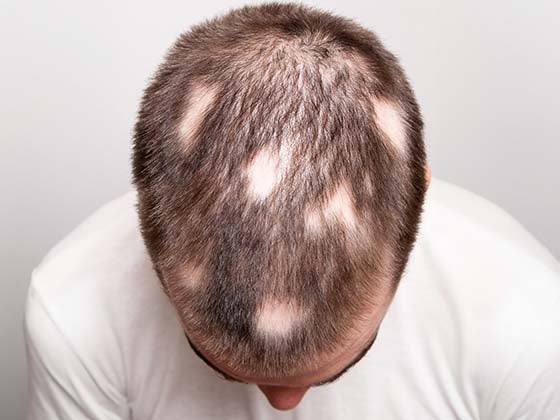- Understanding Male Pattern Baldness
- Stages of AGA
- MPHL Treatment
- MPHL Surgeries
- Emerging Treatment for MPHL
- FAQs
Feeling Hair fall, receding hair line, or a patterned baldness? It can be Male Pattern Baldness or Hair loss.
It’s also known as Androgenetic Alopecia (AGA), and very common in adults. About two-thirds of the population starts noticing some sort of hair loss by the age of 35.
It’s visible in several patterns and is often counted among one of the major cosmetic concerns around the world. What Male Pattern baldness is, its cause, prevention, cure, etc., are some of the topics we'll cover in the blog.
Let’s begin the discussion by understanding this condition and its causes.
Understanding Male Pattern Baldness & Its Cause

Male Pattern Baldness, also known as androgenetic alopecia, is a very common type of hair loss in men. It’s a hereditary (genetic) condition, related to male sex hormones. In simple terms, male baldness is an excessive response of hair follicles to a hormone called dihydrotestosterone (DHT), which causes the follicles to shrink over time.
It’s named because of its predictable and defined pattern that typically involves:
-
A receding hairline that begins above both temples, forming an “M” shape.
-
Hair thinning on the top back of the head (crown area)
-
Formation of a U-shaped (or horseshoe) pattern of hair remaining around the side and back of the head.
It’s a gradual and progressive condition that leads the affected hair to become shorter, finer, and thinner till the follicles stop producing visible hair. Let’s understand the role of DHT in this condition and its effects.
The Role of Dihydrotestosterone

The primary mechanism of Male Pattern Baldness involves the hormone DHT, a potent hormone responsible for male androgenetic alopecia or AGA. Think of it like your body produces testosterone (the main male hormone), and an enzyme called 5-alpha reductase converts a portion of this testosterone into a stronger version: DHT.
The main purpose of dihydrotestosterone is to target the hair follicles that are genetically programmed to be sensitive to it. And, this is the reason, the hair on the side and back often remains, even in patients of AGA.
When DHT targets a follicle, it causes two main problems:
-
Miniaturization: It makes the hair growth cycle shorter and causes the follicles to shrink. Eventually, over time, your normal and thick hair gets replaced with increasingly shorter, thinner, and fainter hair.
-
Dormancy: Over time, the follicle shrinks so much that it becomes dormant and stops growing hair altogether, causing bald spots.
As we discussed earlier, let’s also understand the genetic role in male pattern baldness.

Balding is an inherited trait that comes from either your mother’s or father’s side of the family. Also, your genes decide whether your hair follicles are sensitive to DHT or not. If balding runs in your family, your hair follicles are most likely to have the sensitivity required for DHT to trigger this process. In simple terms, if you have the right genes, the hormone DHT will gradually and permanently shrink your hair follicles until they stop producing thick hair.
Other Hormonal Influences on Hair Health

While DHT plays a major role in genetic hair loss, it’s essential to know that hair growth is regulated by multiple hormones. Imbalances in other areas can significantly affect your hair cycle and can also accelerate hair loss. Let’s have a look at these hormones as well:
-
Stress Hormone (Cortisol): Chronic or severe stress causes your body to produce high levels of cortisol. This can interrupt hair’s natural growth cycle, forcing many hairs prematurely into the resting phase (telogen), resulting in excessive shedding.
-
Thyroid Hormones (T3 and T4): The thyroid gland regulates metabolism, and its hormones are essential for cell growth, including hair follicles. Both increased or decreased thyroid levels can disrupt the hair cycle, leading to noticeable hair thinning or loss.
-
Insulin and IGF-1: Conditions like insulin resistance and metabolic syndrome have been linked to an increased risk of androgenetic alopecia. Additionally, high levels of Insulin-like Growth Factor-1 (IGF-1) can also sometimes play a role in the progression of hair loss.
Now, when we know the reason, to avoid this, it’s important to detect the conditions in the early stages. And, hence, knowing its stages becomes important.
Stages of Male Pattern Baldness: The Norwood Scale

Male Pattern Hair Loss is a predictable Pattern, and often remains the same. The predetermined stages of male pattern baldness typically start with a receding frontal hairline and loss of hair from the top of the head.
The Norwood Scale (or Hamilton-Norwood Scale) is the leading classification system utilized by clinicians and surgeons to measure the extent or stages of male pattern baldness.
Let’s have a look at the seven main stages of progression:
-
Stage 1: This is an early stage of balding that shows no significant hair loss or hairline recession.
-
Stage 2: A noticeable or slight hairline recession around the temples, often known as an adult or mature hairline.
-
Stage 3: This is considered the first sign of clinically significant pattern baldness. The hairline is deeply recessed at both temples, forming an M, U, or V shape. The recessed areas are either bare or sparsely covered.
-
Stage 3 Vertex: The temporal hairline may remain at Stage 2, but noticeable hair loss develops specifically on the crown of the scalp.
-
Stage 4: These are even more severe hairline recessions than Stage 3, combined with sparse or no hair on the vertex. These two balding areas (temples and vertex) are separated by a band of hair that connects to hair on the sides of the scalp.
-
Stage 5: The two hair loss areas are larger than in Stage 4, and separating the band of hair between them becomes narrower and sparser.
-
Stage 6: In this stage, the balding areas of the temples and vertex merge, and the connecting band of hair across the top of the head is sparse or entirely gone.
-
Stage 7: It’s the most severe stage of hair loss, where only a thin or fine band of hair remains around the sides and back of the head.
Apart from these stages, there is a less common pattern known as Norwood Class A variation, where the hairline recedes uniformly from front to back, without leaving a central hair island or a separate bald spot at the vertex.
The Diagnosis of Male Pattern Hair Loss is straightforward, relying on the history of loss, the characteristic pattern, and family history. What to do after detecting androgenetic alopecia? Let’s have a look at the most common treatment, often recommended by dermatologists. But if you’re seeking any such condition, it’s important to always consult a dermatologist.
Treatment Plan Recommended for Male Pattern Hair Loss

Male Pattern Baldness treatment focuses on two main goals:
-
Stopping the Hair from falling out
-
Encouraging new hair to grow back
Starting the treatment early is important in AGA, as it’s much harder to revive hair follicles that have been dormant for years. The FDA has approved two main medications for men's hair loss pattern baldness, and both require continued use to keep the benefits. Both of these medicines are prescribed medications and thus, they should only be used after a dermatologist consultation.
1. Topical Minoxidil (Over-the-Counter Solution)
Minoxidil is one of the frequently used and widely available products. It comes as a liquid or a foam that you can apply directly to your scalp. It boosts the blood flow and works by signalling the scalp. In simple terms, it basically wakes up the hair follicles and helps them stay in their active growth phase longer.
-
What to Use: It’s available in 2% and 5% strengths. Some common products include Mintop Forte 2% Solution and Mintop Forte 5% Solution. These medications are highly effective and are often recommended to be used twice daily.
-
When to Expect Results: If topical minoxidil works for you, you will start to see results after 6 to 12 months of consistent use.
-
Stopping Treatment: If you stop using minoxidil, all the therapeutic benefits will be lost, and you’ll start witnessing hair loss again within 6 to 12 months.
-
Common Side Effects: Usually, some of the common issues noticed with the usage of minoxidil are minor scalp irritation, redness, or itching. Increased absorption of minoxidil topically, though rare, may cause cardiovascular/heart-related side effects. Some people experience temporary hair shedding in the first couple of months as old hair make way for new ones, which is actually a sign that it’s working.
2. Oral Finasteride (Prescription Pill)
Finasteride is a dermatologist-suggested pill and is often taken once a day. It’s a targeted treatment. It works by blocking the enzyme (5-alpha reductase) that converts testosterone into DHT. By reducing the DHT level in the scalp and blood by about 65-70%, it protects the follicle and stops hair fall.
-
Effectiveness: It’s highly effective at stopping hair loss, slowing further thinning in 8 to 9 out of every 10 men who use it. Oral Finasteride also causes significant hair regrowth in about two-thirds of men.
-
When to Expect: It takes time to alter hormone levels and grow new hair; hence, the results are usually noticeable within 6 months to 1 year.
-
Stopping Treatment: Like minoxidil, you must keep taking the pill daily to maintain your hair. The hair loss will resume after stopping the medication.
-
Side Effects: Finasteride may cause sexual side effects, such as decreased sex drive (libido), difficulty getting or maintaining an erection, or ejaculation problems. Thus, doctors nowadays prefer topical finasteride over oral ones.
It’s also important to know about the Post-Finasteride Syndrome (PFS), which is a highly debated issue. Some patients report persistent sexual, neurological, and physical side effects that last for months or years after they’ve stopped taking the medication. Though the exact cause and incidence aren’t proven yet.
3. Other Effective Strategies
As we discussed earlier, a few side effects of finasteride, thus, a solution with the combination of Minoxidil and finasteride is often preferred over oral ones for male pattern hair loss treatment. There are also a variety of natural options available that offer brilliant results. Let’s quickly have a look at these strategies as well:
-
Topical Saw Palmetto Extract (Natural Alternative)
If you’re looking for a natural approach to control hair thinning, one of the most recommended choices available is topical saw palmetto. Saw palmetto comes from a small palm tree, and its extract is often added to shampoos, serums, or scalp rubs for easy application. It acts as a natural “DHT blocker” that stops the enzymes that create DHT right in your scalp. By applying it directly to your scalp, you aim to protect your hair follicles locally without affecting the rest of your body as much as a pill might. It’s often considered a gentler option that can be very helpful in the early stages of male pattern baldness.
-
Combination Therapy (Using Both)
For more significant hair improvement and to avoid side effects, doctors often recommend using a combination of minoxidil and finasteride solution, such as Morr F 5% Solution. This combination works via different biological pathways, and using them together provides a stronger defence against hair loss. -
Shampoos
Using Finasteride along with a Ketoconazole-based shampoo is also believed to bring brilliant results. Ketoconazole-based shampoo, such as Ketocip 2% Shampoo is widely recommended by dermatologists as an adjunctive therapy for male pattern baldness. But it should be noted that it’s a prescribed shampoo and should only be taken after consultation with a dermatologist.
There are also some surgical procedures that are needed in some cases for effective and permanent results. Let’s also discuss a bit about it.
Surgical Options for Hair Restoration

There are a variety of surgical options available, offering permanent results to male pattern baldness patients. Hair transplantation involves relocating hair follicles from the androgen-resistant donor site (usually the sides or back of the scalp) to the bald or thinning areas.
1. Follicular Unit Transplantation (FUT) - The Strip Method
-
Technique: FUT involves removing a strip of scalp tissue from the donor area, which is then dissected into individual hair grafts.
-
Invasiveness/Scarring: This is a more invasive procedure that results in a long linear scar at the donor site. This scar may be visible if the hair is worn short.
-
Time & Cost: FUT is less time-consuming, allowing a large number of grafts to be transplanted in a single session. It is generally more cost-effective (less expensive) than FUE.
-
Recovery: Has a longer recovery period of around two weeks, focused on healing the strip incision.
-
Best for: Patients with dense donor hair who plan to keep their hair longer to conceal the scar.
2. Follicular Unit Extraction (FUE)
-
Technique: FUE is a minimally invasive procedure where individual hair follicles are extracted directly from the donor area using a specialised punch tool.
-
Invasiveness/Scarring: Results in less visible scarring, often leaving only tiny, scattered round scars (typically 1.5–1.6 mm diameter) that are easily concealed, even with short hairstyles.
-
Time & Cost: It is a more meticulous and time-consuming process, often requiring longer surgeries or multiple sessions. Generally more expensive than FUT.
-
Recovery: Has a shorter recovery period of about one week.
-
Best for: Patients who prefer clipped hairstyles, need a smaller number of grafts, or have limited donor hair density (as follicles can be harvested from various parts of the scalp).
3. Surgical Combination with Medication
Since surgery doesn’t ensure future progression of AGA, combining the surgery with medical therapy is superior to surgery alone. Dermatologists often recommend Follicular Unit Transplantation (FUT) with Finasteride 1 mg daily for better clinical outcomes (increased hair density) and may reduce post-operative progression. But it’s always recommended to consult a dermatologist before taking these medications.
Emerging Treatment Options for Hair Pattern Baldness

There are a variety of male pattern hair loss treatments emerging nowadays to support men seeking additional support alongside medications or surgery.
-
Low-Level Laser Therapy(LLLT): These devices (combs or helmets) are available and FDA-approved as safe treatments. LLLT devices work by exposing the scalp to low levels of light, potentially stimulating cell proliferation and increasing hair count. These devices are often used as supportive therapy that improves the results of other procedures.
-
Platelet-Rich Plasma (PRP): PRP involves injecting a patient's own (autologous) preparation of plasma rich in growth factors into the scalp. Platelet-Rich Plasma often lessens hair loss and potentially leads to hair thickening or regrowth. It requires maintenance treatments, usually monthly initially, followed by sessions every three to six months. While it’s a widely practised procedure, there is currently little standardised evidence to objectively support its widespread use in Androgenetic Alopecia.
We all have heard that prevention is better than cure. And thus, understanding the management and prevention for Men Pattern Hair Loss is also an essential thing to consider. So, let’s see some easy-to-follow steps to manage MPHL.
Lifestyle, Diet, and Natural Remedies for Male Pattern Baldness

Male Pattern Baldness is a chronic, genetically determined condition, and thus; prevention completely depends upon early recognition and adherence to consistent treatment. While you can’t change your genes, adopting healthy habits can significantly slow progression and improve treatment efficacy. Let’s have a look at some of the lifestyle adjustments that help you improve your hair health.
1. Lifestyle Adjustments for Hair Health

To maintain a healthy lifestyle, you must add these things to your routine:
-
Avoid Smoking: Smoking introduces your body to several harmful chemicals that can damage your hair follicles and constrict blood vessels. It can reduce circulation around your scalp and speed up hair thinning. You can avoid it by just quitting smoking.
-
Manage Stress: High Cortisol levels can lead to hair shedding. Regularly practising stress-reduction techniques like meditation, deep breathing exercises and yoga can protect your hair.
-
Gentle Hair Care: Avoid hairstyles that cause repeated tension on your follicles (such as tight ponytails or braids), leading to traction alopecia. You can limit the use of excessive heat styling tools and harsh chemical treatments to prevent breakage and cuticle damage.
-
Prioritize Sleep: Getting better sleep is necessary to offer relaxation to your body. Poor sleep quality disrupts hormonal balance, which affects hair growth cycles. Aim for 7-9 hours of quality, restful sleep nightly.
2. Nutritional Support for Stronger Hair

Taking a well-balanced diet or supplement strengthens your hair follicles, and if your diet lacks any of them, your hair will suffer.
|
Essential Nutrient |
Key Role in Hair Health |
Food Sources |
|
Protein |
Hair is made of keratin (protein); inadequate intake weakens the hair shaft. |
Lean meats, eggs, fish, legumes, nuts, seeds. |
|
Iron |
Necessary for oxygen transport; iron deficiency is a common cause of shedding. |
Lean red meat, spinach, lentils, fortified cereals. |
|
Zinc |
Important for hair tissue growth and repair. |
Oysters, beef, pumpkin seeds, lentils. |
|
Biotin (B7) |
Required for keratin production; a popular hair supplement. |
Eggs, nuts, salmon, avocados, sweet potatoes. |
|
Omega-3 Fatty Acids |
Nourishes the scalp and reduces inflammation. |
Fatty fish (salmon), flaxseeds, walnuts. |
3. Natural & Home Remedies

Natural and home remedies are supportive therapies and not substitutes for medications, but they actually work and support scalp health and circulation. Saw palmetto wasn’t the only natural product helpful for hair growth; there are many. Let’s have a look:
-
Essential Oils: Several Oils, such as Rosemary Oil and Peppermint Oil, can stimulate circulation and promote blood flow. Massaging it into the scalp can truly be helpful and lead to better hair growth.
-
Scalp Massage: A daily scalp massage using fingertips in circular motions can help improve the blood circulation to the hair follicles, encouraging growth and nutrient delivery.
-
Hydration and Protection: It’s one of the most used hair care advice often given by dermatologists. Simply just drink plenty of water. Additionally, protect bald or tinning areas from the sun using sun protection or a hat, as UV damage can harm the scalp, accelerating the hair loss and thinning.
By understanding the progression laid out by the Norwood scale and exploring these proven medical and surgical treatments, men can effectively manage and prevent male pattern baldness and proactively maintain hair density.
Final Thought: Dealing with Male Pattern Baldness
The very first problem that arises with Male Pattern hair Loss is social anxiety. As we’ve discussed above that it’s one of the most common cosmetic problems all around the world and nothing to be ashamed of.
If you have a family history of baldness, you must consider it as an early warning and seek proper consultation with a dermatologist to prevent or avoid it. As it's a genetic condition, following a healthy hair care routine, and taking appropriate medication can protect your hair volume and follicles.
If you’re someone experiencing hair loss, it’s necessary to consult a dermatologist quickly, and do consider only dermatologist recommended hair care products.
Do exercise, take hair regrowth supplements, hydrate your scalp, and follow a good hair care routine.









































